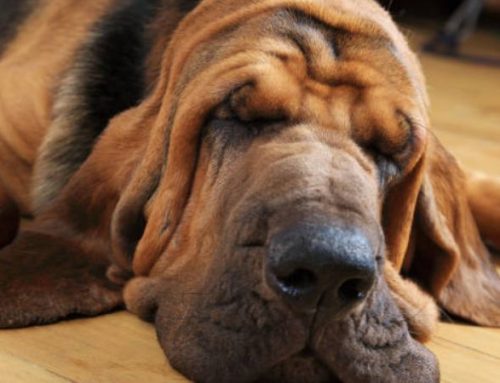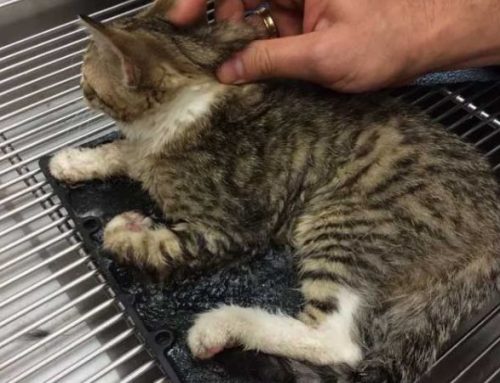Tired of finding dog hair on your clothes, furniture, and just about everywhere else? You’re not alone. Shedding is a normal part of life with dogs, but it doesn’t have to take over your home.
At Nexus-Pets, we’ve put together the ultimate guide to help you manage shedding and keep your space clean without the constant vacuuming. From smart grooming tips to simple daily habits, here’s how to reduce shedding and enjoy a more hair-free home with your furry friend.

Regular Grooming: The Key to Shedding Control
Consistent grooming is one of the most effective ways to reduce shedding and maintain a clean, healthy coat. Brushing your dog daily—or at least several times a week—not only removes loose fur before it ends up on your floors and furniture, but also helps distribute natural oils across the skin and coat, keeping both healthier and shinier.
Choosing the right brush for your dog’s coat type is essential for getting the best results:
- Bristle brushes are versatile and work well on all coat types, especially short, smooth coats. They’re great for everyday maintenance.
- Wire-pin brushes are ideal for dogs with curly or woolly coats, like Poodles or Bichon Frises, as they gently work through curls without pulling.
- Slicker brushes are excellent for detangling mats and removing loose fur from medium to long-haired breeds.
- Rubber curry combs work best on short-haired dogs and offer the added benefit of massaging the skin while lifting away loose hairs.
In addition to brushes, deshedding tools—such as undercoat rakes and deshedding blades—can be incredibly helpful for double-coated breeds like Huskies, Retrievers, or German Shepherds. These tools reach deep into the coat to remove dead undercoat hair before it sheds. However, it’s important to use them gently and follow the manufacturer’s instructions to avoid irritating the skin.
Regular grooming doesn’t just minimize shedding it also prevents tangles and mats, promotes healthy skin by improving circulation, and provides an opportunity to check for any skin issues, parasites, or unusual lumps early on. With the right tools and routine, grooming becomes a bonding experience and your first line of defense against loose hair invading your home.
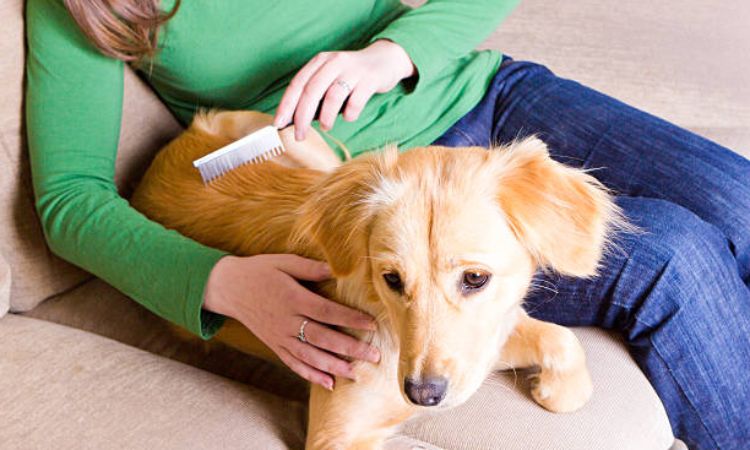
Proper Bathing and Coat Care
When it comes to managing shedding, bathing plays a crucial role in maintaining your dog’s skin and coat health. However, it’s important to strike the right balance—bathing too often can strip the skin of natural oils, while not bathing enough can lead to buildup of dirt, dander, and loose fur. In general, most dogs benefit from a bath every 4 to 6 weeks, but this can vary based on breed, activity level, and coat type.
Using a high-quality de-shedding shampoo and conditioner is a smart move for heavy shedders. Look for products enriched with Omega-3 fatty acids, which help nourish the skin, reduce inflammation, and support a healthy coat from the outside in. These products can also loosen dead undercoat hair, making it easier to remove during brushing or blow-drying sessions.
Bathing is also effective for removing dirt, allergens, and dead hair that would otherwise end up on your floors and furniture. It helps hydrate dry skin, soothe irritation, and improve coat texture—especially when paired with a moisturizing conditioner designed for shedding control.
That said, it’s essential to avoid harsh or overly fragrant shampoos, especially those containing sulfates, alcohol, or artificial dyes. These ingredients can dry out the skin, causing irritation or even increasing shedding in sensitive dogs. If your pup starts scratching more after a bath or shows signs of flaky skin, it’s time to switch to a gentler, vet-approved formula designed for their coat needs.
Nutrition and Hydration for Healthy Fur
Maintaining your dog’s coat health starts from the inside out, and a balanced diet plays a vital role in this. Providing your dog with food rich in essential vitamins and nutrients ensures their hair follicles remain strong and resilient, which helps reduce shedding and promotes a shiny, healthy coat.
- Balanced Diet: Make sure your dog’s food contains important nutrients like biotin, zinc, vitamin E, and amino acids that support skin and fur health.
- Omega-3 Fatty Acids: These healthy fats, often found in fish oil or flaxseed oil supplements, help decrease inflammation, improve skin moisture, and enhance the texture and shine of your dog’s fur. Always consult your veterinarian before starting supplements to find the best option for your dog.
And Adequate water intake is essential for keeping your dog’s skin hydrated and preventing dryness, which can worsen shedding. Typically, dogs need about one ounce of water per pound of body weight each day, but individual needs may vary.
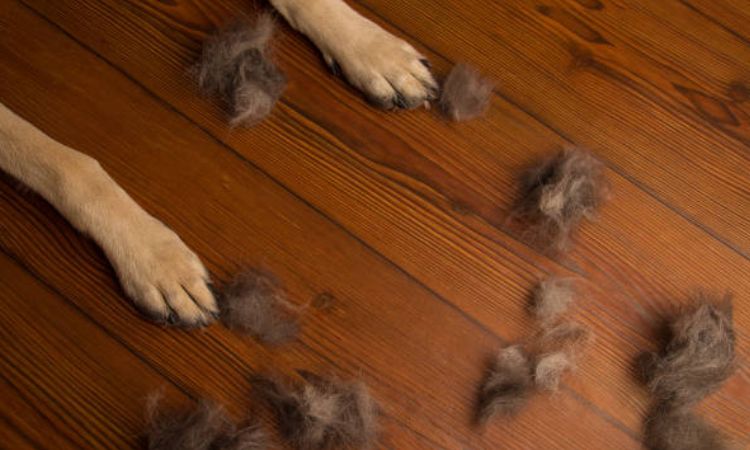
Environmental and Lifestyle Factors
Shedding in dogs can be influenced not only by genetics and health but also by their environment and daily lifestyle. Managing these factors effectively can help reduce excessive shedding and keep your dog comfortable and healthy.
Keeping Your Dog Cool in Hot Weather
Heat is a major trigger for increased shedding, especially in breeds with thick or double coats. When temperatures rise, dogs shed their heavier winter undercoat to stay cool. Providing a cool, shaded environment and plenty of fresh water can help regulate your dog’s body temperature and reduce heat-related shedding. Avoid overexertion during the hottest parts of the day, and consider grooming tools that help remove loose fur before it accumulates.
Managing Stress and Providing Regular Exercise
Stress is a surprisingly common cause of increased shedding. Changes in routine, loud noises, trips to the veterinarian, or introducing new family members can trigger anxiety-related shedding. Consistent daily exercise, mental stimulation, and creating a calm, secure environment can help minimize stress-induced hair loss. Spending quality bonding time through grooming sessions can also soothe your dog and reduce anxiety-related shedding.
Regular Veterinary Checkups
Excessive shedding can sometimes indicate underlying medical problems such as parasites (fleas, ticks, mites), allergies, hormonal imbalances, or skin infections. Regular vet visits allow early detection and treatment of these conditions before they worsen. Your veterinarian can recommend preventive measures, diagnostic tests, or specific treatments tailored to your dog’s needs, ensuring their coat and skin remain healthy and shedding stays within a normal range.
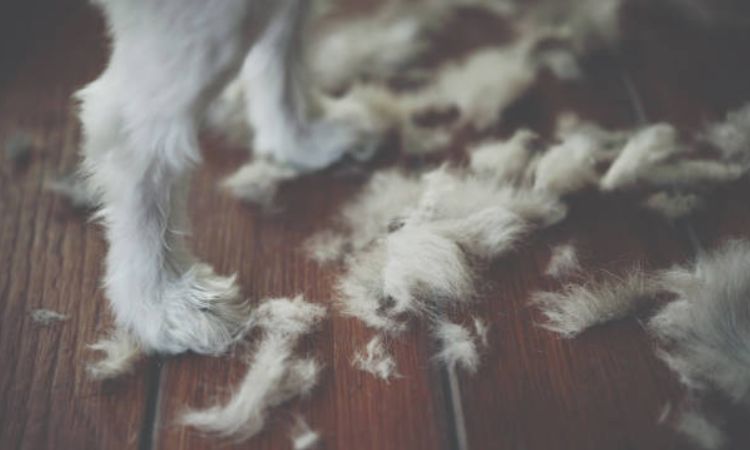
Home Cleaning Tips for Managing Dog Hair
- Vacuum regularly, ideally daily or several times a week, using a vacuum cleaner equipped with HEPA filters or specialized pet hair attachments. This helps capture fur and dander that settle on floors, carpets, and furniture, reducing allergens and keeping your home cleaner.
- Employ lint rollers and rubber pet hair removers to quickly lift hair from clothing, upholstery, and car seats. These tools are handy for spot cleaning between deeper cleans.
- Protect your furniture with washable covers or throws that trap dog hair and can be easily cleaned. Train your dog to stay in designated areas with these covers to limit fur spread.
- Use simple laundry tricks like adding white vinegar to your wash cycle or tossing pet hair catchers into your washer and dryer. These methods help loosen and remove hair embedded in clothing and blankets.
- Establish dog-friendly zones with easily washable rugs or mats to contain shedding. Consistent training to keep your dog in these areas can significantly reduce hair around your living spaces.
If you’ve implemented the tips in this guide, you should see a noticeable difference in your dog’s shedding and the amount of hair in your home. Remember that some shedding is completely normal, but by staying consistent with a quality diet, regular grooming, and paying attention to your dog’s health, you can keep it under control. Enjoy your cleaner home and a happier, healthier companion!


